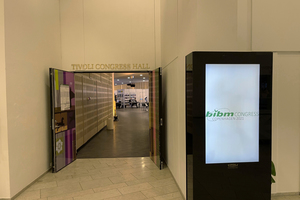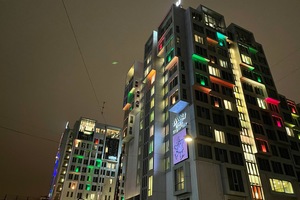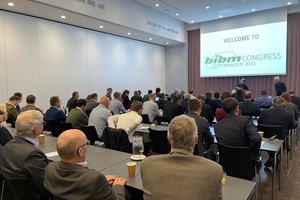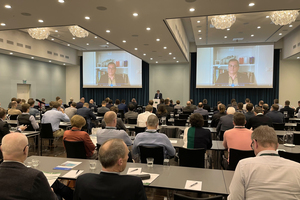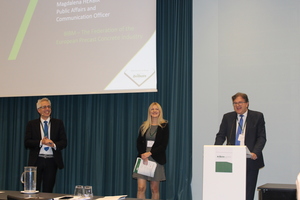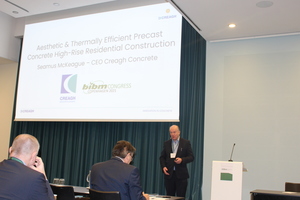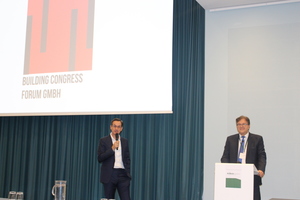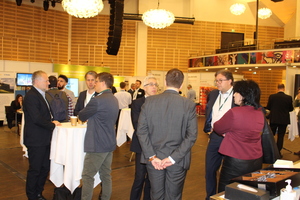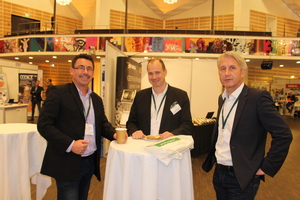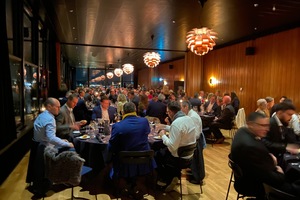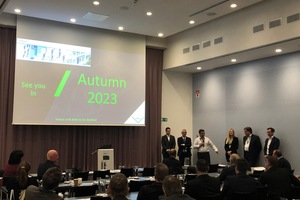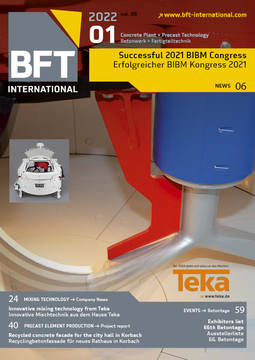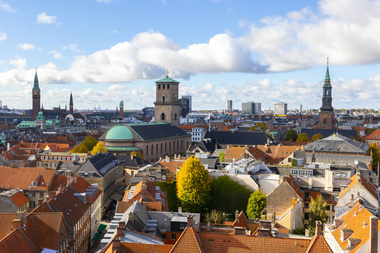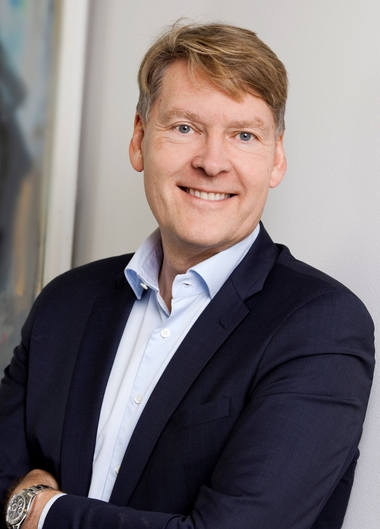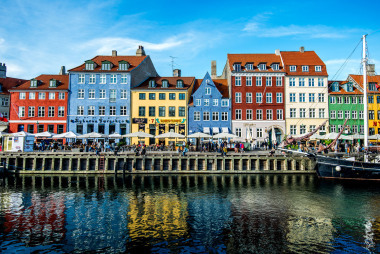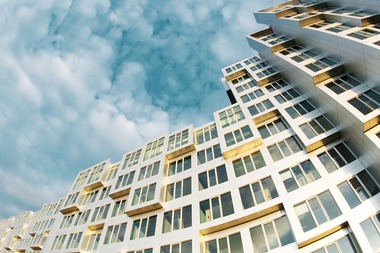Successful 2021 BIBM Congress in Copenhagen
After a delay of one and a half years caused by the Covid-19 pandemic, the 23rd BIBM Congress took place in Copenhagen from 14 to 16 November 2021. Bureau International du Béton Manufacturé (BIBM), the European precast federation, joined forces with the organizers of BCF - Building Congress Forum GmbH to invite interested industry representatives to the Danish capital. About 350 people from across Europe attended the event and convened in the Tivoli Congress Center under the Covid-19 guidelines and regulations applicable in Denmark. The technical program focused on building with precast elements in the Nordic countries. Accordingly, the congress was held under the heading “The Future of European Construction – Precast Excellence in Nordic Countries”. In addition to best-practice examples from these countries, the agenda addressed megatrends such as digitization, the circular economy and decarbonization.
Focus on the precast industry
Increased demand, rising prices, resource scarcity and stricter climate protection requirements pose enormous challenges to the construction industry, as the Dutch BIBM President, Bart van Melick, pointed out in his opening speech transmitted via remote video. According to him, concrete takes center stage because it is the most widely used building material in the world. Nonetheless, he was positive with regard to the future in view of the many beneficial properties of concrete and the advantages of precast elements. Although the route towards this future will certainly not be easy, the precast industry demonstrates an outstanding ability to innovate and provides futureproof solutions, as was also underscored by the lectures delivered at the congress.
BIBM Secretary General, Alessio Rimoldi, and the federation’s Head of Public Relations, Magdalena Herbik, first outlined the measures envisaged as part of the “European Green Deal” and their effects on the industry. The European Commission intends to achieve climate neutrality for Europe by 2050. To reach this goal, net greenhouse gas emissions need to be reduced by at least 55% by 2030 compared to 1990. In their presentation, they highlighted the ways in which the precast industry can contribute to achieving these climate mitigation targets. In doing so, they referred to the new edition of the “Little Green Book”, which presents the many benefits of precast in a compact format and was distributed to the public for the first time at the BIBM Congress. Seamus McKeague, President of the International Prestressed Hollowcore Association and Managing Director of Creagh Concrete Products Ltd, then went into some detail regarding the advantages of precast, such as fire safety, shorter construction times and design variety, and presented completed residential and commercial buildings in the United Kingdom and Ireland.
Best-practice examples from Scandinavia and Finland
Project examples from the Scandinavian countries and Finland provided interesting starting points for the ensuing discussion. These countries play a pioneering role in terms of prefabrication. Architect Bo Christiansen, of Scaledenmark, explained how Copenhagen is setting new standards for sustainable urban development. Supported by design sensitivity, political foresight and green mobility, the Danish capital has set out on its path to becoming a carbon-neutral metropolis as early as 2025. JAJA Architects are also concerned with making the city worth living in and adding value with its buildings. Kathrin Susanna Gimmel presented the example of the Lüders multi-story car park at the former port. Its eight floors provide sufficient parking space while offering a rooftop area that invites people to play, do sports and linger. As part of the “Ressource Blokken” research project, the practice is currently working on the construction of a housing estate made of precast elements that were already used in the 1960s and 1970s. Accordingly, they urge precast producers to support the concept of upcycling and to also become “precast concrete re-users”. Finnish architect Kimmo Lintula, of K2S Architects, also made a groundbreaking contribution. He presented sustainable architecture made of concrete that uses innovative technologies such as concrete core activation.
Circular economy
The aspect of sustainability took center stage throughout the congress. Contributions on research projects such as SeRaMCo by Prof. Dr.-Ing. Christian Glock, of Kaiserslautern University of Technology, or VEEP and RE4 (RE4 – REuse and REcycling of CDW materials and structures in energy efficient pREfabricated elements for building REfurbishment and construction) presented by Zuzana Tatáková, project manager at Fenix TNT, highlighted the potential of precast elements for implementing a circular economy. For instance, optimizing recycled concrete mixes paved the way towards developing new applications for load-bearing and non-load-bearing precast components. In addition, the recycling of construction and demolition waste and the use of demountable precast elements make it possible to design buildings whose components can be dismantled completely and recycled at the end of their life cycle, thus significantly reducing the amount of generated waste.
Another pertinent example is the “Circle House” project, which demonstrates that circular yet low-cost construction is feasible in actual practice. In a newly developed residential area near Aarhus in Denmark, the world’s first public housing units conforming to the circular economy principle were completed. Kasper Guldager Jensen, co-founder of Home.Earth, and Topi Paananen, of Peikko Group, reported on the project and the innovative connection technology used, which allows for easy dismantling of the precast elements.
Decarbonization
Decarbonization can make a substantial contribution to reducing the environmental footprint of the construction industry. In addition to new low-carbon raw materials for cement clinker and concrete production, the capture of carbon dioxide in the cement plant and its use or storage play an important role. Claude Loréa, Managing Director of the Global Cement and Concrete Association in Brussels, outlined the cement and concrete industry’s plan to achieve “net zero” carbon emissions by 2050. Anne Rønning, of Østfold Research Institute, and Christian John Engelsen, Infrastructure Research Scientist, from Norway presented their research project on binding carbon dioxide in concrete. For Prof. Karen Scrivener, University of Lausanne, the use of concrete is indispensable in view of the increasing demand for construction and the limited supply of wood. For future projects, she favors low-clinker cements in which a considerable portion of the limestone is replaced by clays since their available reserves are considerable and far from being exhausted.
Another important aspect of the sustainability debate is how to communicate and interact with policy makers. One of the main tasks is to break through the frequently entrenched opinions about substitutes such as wood as a supposedly more “sustainable” building material in order to maintain the industry’s competitiveness. For such opinions are often based on emotions rather than scientific evidence.
John-Erik Reiersen, Managing Director of the Norwegian Precast Concrete Association, reported on his personal and data-driven approach to this topic.
Precast products in road construction, gardening and landscaping
Precast products are widely used in road construction, gardening and landscaping. In this context, Sogge Johnsen, Product Manager at Basal, informed congress attendees of innovative, sustainable trends in stormwater management.
Stef Maas, Managing Director of the Belgian Precast Concrete Association, presented the impressive infrastructure of the Flemish cycle path network, which was expanded a few years ago to include a route right through the De Weijers pond landscape in the province of Limburg. The cycle path leads from one bank to the other, but users do not get wet because the cycle path built below the water level is enclosed by retaining walls made of precast elements on both sides, and thus offers a unique cycling experience.
Digitization
It goes without saying that this megatrend determining our future had to be covered at the BIBM Congress. How can the digital transformation in the construction sector succeed? Where are the challenges regarding its implementation on the factory floor? These were the key questions that Christophe Sykes, Director General of Construction Products Europe, addressed in his presentation. The potentials that digitization offers are often neglected or underutilized owing to the decentralized nature of construction. In many places, there is still a lack of the required transparency and communication. One of the building blocks of the digital transformation is Building Information Modeling (BIM). BIM expert Brian Rasmussen, of Bravida Denmark A/S, reported on his hands-on experience and on the barriers to be overcome when implementing BIM at the corporate level. Alejandro Lopéz Vidal, of the Spanish Precast Concrete Association, used his presentation to urge the industry to come to terms with digitization and its specific challenges as early as possible. New methods such as BIM and innovative technologies such as 3D concrete printing and augmented reality open up new opportunities to increase operational efficiency and to secure one’s competitive edge.
Prof. Benjamin Kromoser, of the University of Natural Resources and Life Sciences (BOKU), Vienna, agreed with this view. In view of the prevailing shortage of skilled workers, new digital design and automated production methods provide high potential for increasing productivity significantly. He also referred to other levers for implementing more efficient and resource-saving production processes in the precast industry, mentioning starting points on the material, structural and fabrication levels.
Innovations of the supplier industry
Congress participants also attended the two “Innovation Workshop Sessions” in large numbers. In these sessions, selected exhibitors delivered brief presentations to showcase their technical solutions for day-to-day production. The congress was accompanied by an exhibition featuring 73 companies from the international supplier, engineering and software industries, led by the main congress sponsor, BASF Master Builders Solutions.
Networking
The supporting program for accompanying persons provided the opportunity to get to know the Danish capital a little better. One of the highlights for all those taking part was the evening event held in the historic Langelinie Pavilion. This generously dimensioned, listed building constructed in the 1950s not only opened up magnificent views across the skyline and the harbor of Copenhagen – its mid-century style of Danish interior design also provided the perfect backdrop for finishing the first congress day on a cozy note.
Attending continuing training without restrictions, conversing with colleagues and market partners and talking shop: For a few days, the BIBM Congress felt like being back to “normal” – a backdrop that will hopefully be possible again for anyone and anywhere in the world in the foreseeable future. Accordingly, the two managing directors of BCF - Building Congress Forum GmbH, the organizing entity, Dr. Ulrich Lotz and Michael Voss, expressed their satisfaction: “What has always been special, of course, is the European idea behind it. This year’s motto was ‘Precast Excellence in Nordic Countries’.
The congress presented many interesting insights, including the fact that the industry in the ‘Nordic’ countries has already progressed much more significantly than elsewhere and that precast construction is approached quite differently there.”
The next BIBM Congress will take place in 2023. Its venue will be announced in spring 2022.
CONTACT
BIBM
The European Federation for Precast Concrete
Rue d’Arlon 55 – 6th Floor
1040 Brussels/Belgium
Building Congress Forum
Gerhard-Koch-Str. 2+4
73760 Ostfildern/Germany

